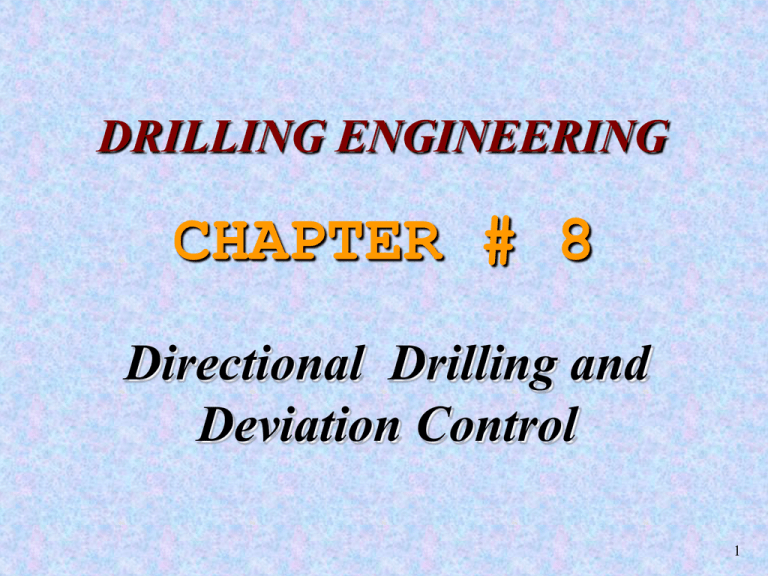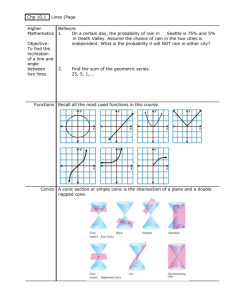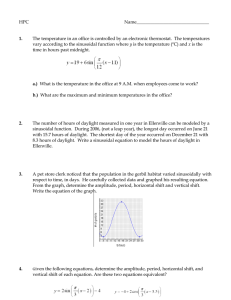Definition
advertisement

DRILLING ENGINEERING CHAPTER # 8 Directional Drilling and Deviation Control 1 Definition Directional Drilling: The process of directing the wellbore along some trajectory to a predetermined target. Deviation Control: The process of keeping the wellbore contained within some prescribed limits, relative to inclination angle, horizontal excursion from the vertical or both. X-Y Plane X – Plane = direction plane Y – Plane = inclination plane 2 Angles X-Y = Plane X – angle = direction angle Y-Z = Plane Y – angle = inclination angle Purpose of Directional Drilling Res. Under lake (economics, environmental reasons) Offshore drilling. Res. beneath population centers. Res. beneath natural obstruction (mountains) Or severe topographical features. Sidetracking out of an existing wellbore to bypass an obstruction (fish) or explore additional producing horizons in adjacent sectors. Relief well to plug a blow out. 3 Inclination and direction planes as a wellbore proceeds in the depth plane. 4 Plan view of a typical oil and gas structure under a lake 5 Typical offshore development platform with directional wells 6 Developing a field under a city using directionally drilled wells 7 Drilling of directional wells where the reservoir is beneath a major surface obstruction 8 Sidetracking around a fish 9 Using an old well to explore for new oil by sidetracking out of the casing and drilling occasionally 10 7.1 Planning The Directional Well Trajectory Trajectory Well path that will intersect given target. First design propose the various types of paths that can be drilled economically. Second includes effects of geology on the bottomhole assemblies (BHA) and other factors that could influence the final wellbore trajectory. 11 Types of Trajectories Build and hold trajectory penetrates target at max. build-up angle. Build-hole and drop (s-shape) penetrate angle vertically Build-hold drop and/or hold (modified s-shape) penetrates target at angle less than max. inclination angle in the hold section. Continuous build trajectory inclination angle is increasing. q1 < q3 < q2 < q4 12 X3 = horizontal departure g1 = radius of curvature D3 = TVD true vertical depth D1 = kick off point TVD q = rate of inclination angle build up 13 Geometry of build-and-hold type well 14 7.2 Build and Hold Trajectory Circumference = 2pr S=rq q in radians max. inclination angle 1 radian = 180 o/p = 57.29578 o 1o = p/180 radians q = degrees per unit length = q/L = inclination angle build up rate q = 1o/100ft r = S /q r = radius of curvature 15 S=gq 1 g q S deg rees q length 1 length g q deg rees 1 length 180 g q deg rees p 180 1 180 or q g1 p q g 1p (8.1) 16 q=W-T (8.2) To find angle T look at triangle OBA BA g 1 - X 3 tan T AO D3 - D1 T arctan g1 - X3 D3 - D1 (8.3a) (8.3b) To find angle W consider triangle OBC CO SinW BO (8.4) 17 CO = g1 BO (OA) 2 ( BA) 2 BO ( D3 - D1 )2 (g 1 - X 3 )2 SinW g1 (g 1 - X 3 ) ( D3 - D1 ) 2 (8.5) 2 g1 W arcsin (g - X )2 ( D - D )2 1 3 3 1 q=W-T 18 g1 q arcsin (g - X )2 ( D - D )2 1 3 3 1 - arctan g 1 - X 3 D -D 1 3 (8.6) Length of the arc section DC (buildup section) DC r1q p p 180 1 r1 180 q DC q q (8.7) 19 Length of CB (Trajectory Path) Straight at constant inclination angle can be determined from BCO CO r1 tan W CB CB r1 CB tan W Total measured depth DM for TVD of D3 is q r1 Dm D1 q tan W (8.8) 20 Horizontal departure at end of build up X 2 EC consider DOC X 2 r1 - r1 cosq r1 (1 - cosq ) (8.9) True Vertical depth at end of build up section D2 D1 - r1 sin q (8.12) 21 Geometry for the build section 22 Measure depth and Horizontal departure before reaching maximum angle along any part of build up. Consider q intermediate inclination angle q XN=Horizontal Departure at C DN=Vertical depth Consider DOC DN D1 - r1 sin q (8.10) X N r1 - r1 cosq X N r1 (1 -1 cosq ) (8.11) 23 New measured depth for any part of the build up DMN D1 q (8.13) q New measured depth at TVD of (D*< D3)(D2<D*< D3) DMP q D - D1 - r1 sin q D1 q cosq (8.16) Horizontal Departure X* (X2<X*< X3) X r(1 - cosq ) ( D - D1 - r1 sin q ) tan q (8.18) 24 For r1 < X3 D3 - D1 r1 q 180 - arcTan ( ) - arcCos( ) X 3 - r1 D3 - D1 D3 - D1 sin arcTan ( ) X 3 - r1 (8.20) 25 Build-hold-and-drop and hold (modified-S) 26 Directional quadrants and compass measurements 27 Vertical calculation 28 Horizontal calculation 29 Three-dimensional view of a wellbore showing components that comprise the X, Y and Z parts of the trajectory 30 Techniques for making a positive direction change 31 7.3 Directional Drilling Tools Stabilizing Tools The Stiff Hook-Up The Pendulum Hook-Up Angle Building Hook-Ups The Lock-in Hook-Ups Angle Losing Hook-Ups 32 Directional drilling applications 33 Stabilizing tool 34 The use of stabilizers in directional drilling 35 Other Application of Stabilizing Tools Key seat Guide Avoidance of Pressure Differential Sticking Whip stock Knuckle Joint 36 Whip stocks 37 Knuckle joint 38 39 Using a section mill to prepare for a kick-off 40 Jetting bit 41 Jetting a trajectory change 42 Fig 8.95: A typical positive-displacement mud motor (PDM) 43




